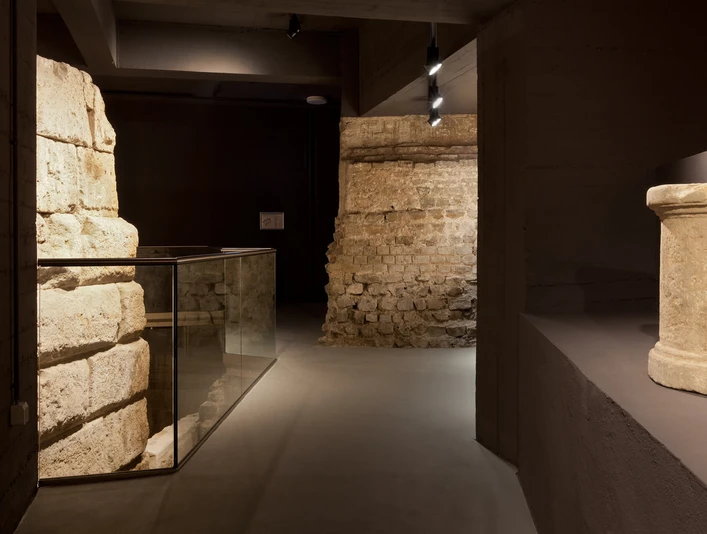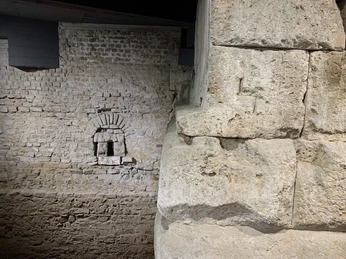- Photos & Map
How would you like to arrive?
- Website
- Details
- Useful Information
- Nearby
A settlement built by the Romans and inhabited by the Ubii emerged—the Oppidum Ubiorum. Remains of this settlement can still be found today in the basement of a building in Cologne: As you descend, you will find the so-called Ubii monument, remains of a large tower, and the oldest securely dated structure of Roman Cologne from the year 5 to 6 AD.
Numbers, data, facts: the corner tower
Originally, the Ubii monument was the southeastern corner tower of the Roman pre-colonial fortification of the Oppidum Ubiorum and was located precisely where the southern and eastern city walls of the Romans converged.
The tower, made of tuff stone with an almost square base measuring approximately 9 by 9 meters, was constructed on a grid of oak piles which were felled in the year 4 to 5. These oak piles, each with a diameter of 16 cm, supported a foundation slab of Roman cement, which in turn supports the tower built of tuff blocks.
Approximately 6 meters of the original 12 meters of the tower's height have been preserved. The tower, which was partially demolished during the construction of the Roman city wall, was presumably part of the city fortifications of the Oppidum Ubiorum and marked the entrance to the Rhine harbor.
Almost for eternity: Tuff blocks, connected in dry stone construction with clamps
A structurally interesting fact: The tuff stone blocks were connected only by metal clamps in a dovetail shape, without mortar—a sophisticated technique that demonstrates the stability and precision of Roman architecture. One of the clamps can still be viewed today.
Backgrounds: To the archaeological discovery
The Ubii monument, built by the Romans in unmistakable Roman technique, was only discovered in 1965 during construction work—during excavation work for a new building at the intersection of An der Malzmühle/Mühlenbach between Cologne's old town and the Chocolate Museum. For the preservation and viewing of the monument, the basement of the building was then redesigned.
Tracing the Romans
At many places in Cologne, numerous testimonies of the 2000-year-old city history lie dormant. You can learn more about Roman Cologne, for instance, in the Roman-Germanic Museum with its world-famous Dionysus mosaic, in the Praetorium, the Roman governor's palace in the MiQua, the LVR Jewish Museum in the archaeological district of Cologne, in the preserved part of the underground Roman sewer, or directly at the Cologne Cathedral at the Roman archway. You can also walk along a Roman harbor road in Cologne or learn more about the once 100 km long Eifel aqueduct.
Excursion: To the Ubii
Already 30 years before the relocation of the Ubii to the left bank of the Rhine, the Romans came into contact with this Germanic tribe from the right bank of the Rhine. Their relocation was presumably due to the fact that in the eyes of the other Germanic peoples, they appeared as traitors—after all, they joined forces with the Romans and hoped to gain advantages from it.
The Ubii owned ships and engaged in trade and were possibly Celticized Germans who lived in the German Central Uplands, which is considered an intermediate zone of Celtic and Germanic cultures. They traded actively with the Romans, paid tributes, and provided auxiliary troops to subdue other Germanic tribes. From the 3rd century, their descendants merged into the Franks of the Rhine.
Useful Information
Eligibility
Bad Weather Offer
Suitable for any weather
for Groups
for Class
for families
for individual guests
Suitable for the Elderly
Openings
Parking facilities
Nearby


